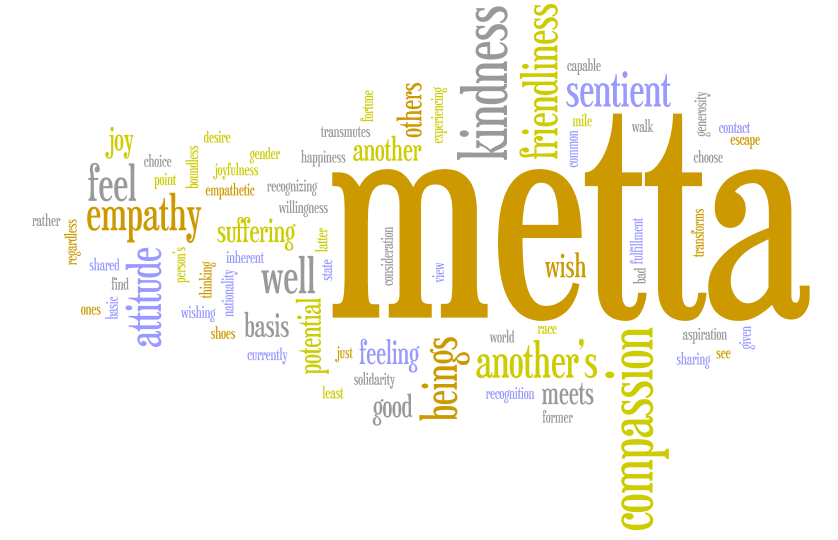People often believe that Buddhism focuses on suffering and all the depressing things about life. Even if that were true, the fourth Brahmavihara clearly balances out the picture a little better. Mudita, sometimes translated as empathetic or unselfish joy, focuses on how we can share in the joy that is all around us.
Some writers think that mudita is a foundational aspect of the Brahmaviharas - that it's difficult to feel compassion or loving-kindness toward someone until you can first find something you appreciate about them. I tend to think that it's actually the hardest of the four, because it's the one we have the least practice with. Most people already have lots of experience with feeling loving towards others, including starting with little of that feeling and watching it grow over time. We have lots of experience sharing other people's sorrows and feeling some compassion for them. I think that most people have far less experience sharing someone else's joy without feeling competitive, envious, or jealous.
Many years ago I went to a university department faculty function and was asked by one of the main faculty members what was new? I had just been invited to edit a book by a publisher, and that was what was new, so that's what I told her. She said, "Well, the only reason they asked you is because they couldn't get someone good."
I thought this was a pretty funny response. Despite the fact that my success was actually good for the whole department (and therefore also good for her), she couldn't share in the joy. I don't know if she was threatened, or jealous, or what, but this response was a classic example of what we usually do when we hear about someone else's good fortune--we turn it around and look at it from our own limited perspective. We make it about us, even though it's clearly not about us - it's about the other person.
Mudita is often referred to as an antidote to envy, jealousy, competition, or resentment. So when you are feeling one of those types of emotions, we can try to do a mudita meditation to reduce it. The traditional phrase to offer is "May your joy and good fortune not diminish," or "May this good fortune continue, return, and increase." Traditionally we would start by offering this to a friend, remembering a time when that friend got something he/she really was hoping for, and then offering the phrase. After this, you can extend the offering to a loved one, a neutral person, a difficult person, and all beings.
Although the traditional meditation practice doesn't usually begin with focusing on the self like many of the other Brahmavihara practices do, there are practices to help us begin to find joy without feeling competitive or envious. One is to find the joy in all the little things that happen in a day that we tend to overlook. Children are an excellent teacher for mudita. Everything they are doing is so interesting and joyful to them that we call it "play." It's really nothing more than them living their lives, but because they approach it with joy in the execution we soon differentiate it from "work." Yet, what is the difference?
This is training we can do all day long - train to notice that almost whatever we're doing has some joyful aspect to it. The key is to be present, fully connected with whatever is happening in this moment and noticing the details of ordinary life. We have the opportunity to rejoice as we take care of ordinary things: our dishes, our clothing, our work, our hair. When we are taking care of something that needs care, we can express appreciation for all of the things that have come together to make it possible. To take out the garbage, for example, means that you had enough money to buy the things that you enjoyed before throwing the useless parts away, and that you are healthy enough to carry the bag out to the garbage can. These are no small joys.
Mudita uncovers the
truth of our abundance.
In the Mangala Sutta, the Buddha is asked what the greatest blessing in the world is. This sutra is funny because it's almost like he couldn't make up his mind. He lists about 37 different things and says they're all the greatest blessing! I think this is the truth...we are blessed in so many directions (family, home, skills, friends, values, etc.) that we don't even notice them.
Ultimately, each of the four Brahmaviharas are balanced by and need the others.
Some writers think that mudita is a foundational aspect of the Brahmaviharas - that it's difficult to feel compassion or loving-kindness toward someone until you can first find something you appreciate about them. I tend to think that it's actually the hardest of the four, because it's the one we have the least practice with. Most people already have lots of experience with feeling loving towards others, including starting with little of that feeling and watching it grow over time. We have lots of experience sharing other people's sorrows and feeling some compassion for them. I think that most people have far less experience sharing someone else's joy without feeling competitive, envious, or jealous.
Many years ago I went to a university department faculty function and was asked by one of the main faculty members what was new? I had just been invited to edit a book by a publisher, and that was what was new, so that's what I told her. She said, "Well, the only reason they asked you is because they couldn't get someone good."
I thought this was a pretty funny response. Despite the fact that my success was actually good for the whole department (and therefore also good for her), she couldn't share in the joy. I don't know if she was threatened, or jealous, or what, but this response was a classic example of what we usually do when we hear about someone else's good fortune--we turn it around and look at it from our own limited perspective. We make it about us, even though it's clearly not about us - it's about the other person.
Mudita is often referred to as an antidote to envy, jealousy, competition, or resentment. So when you are feeling one of those types of emotions, we can try to do a mudita meditation to reduce it. The traditional phrase to offer is "May your joy and good fortune not diminish," or "May this good fortune continue, return, and increase." Traditionally we would start by offering this to a friend, remembering a time when that friend got something he/she really was hoping for, and then offering the phrase. After this, you can extend the offering to a loved one, a neutral person, a difficult person, and all beings.
Although the traditional meditation practice doesn't usually begin with focusing on the self like many of the other Brahmavihara practices do, there are practices to help us begin to find joy without feeling competitive or envious. One is to find the joy in all the little things that happen in a day that we tend to overlook. Children are an excellent teacher for mudita. Everything they are doing is so interesting and joyful to them that we call it "play." It's really nothing more than them living their lives, but because they approach it with joy in the execution we soon differentiate it from "work." Yet, what is the difference?
This is training we can do all day long - train to notice that almost whatever we're doing has some joyful aspect to it. The key is to be present, fully connected with whatever is happening in this moment and noticing the details of ordinary life. We have the opportunity to rejoice as we take care of ordinary things: our dishes, our clothing, our work, our hair. When we are taking care of something that needs care, we can express appreciation for all of the things that have come together to make it possible. To take out the garbage, for example, means that you had enough money to buy the things that you enjoyed before throwing the useless parts away, and that you are healthy enough to carry the bag out to the garbage can. These are no small joys.
Pema Chodron says (in The Places that Scare You, p. 85), “Rejoicing in ordinary things is not
sentimental or trite. It actually takes guts. Each time we drop our complaints
and allow everyday good fortune to inspire us, we enter the warrior’s world. We
can do this even at the most difficult moments. Everything we see, hear, taste,
and smell has the power to strengthen and uplift us.” This is the first stage
in learning joy – learning to practice seeing it in our daily lives. This stage
is made greatly difficult because we have years of practicing doing the
opposite – complaining about every little problem.
The French writer Collette said, “What a wonderful
life I’ve had! I only wish I’d realized it sooner.”
In the Mangala Sutta, the Buddha is asked what the greatest blessing in the world is. This sutra is funny because it's almost like he couldn't make up his mind. He lists about 37 different things and says they're all the greatest blessing! I think this is the truth...we are blessed in so many directions (family, home, skills, friends, values, etc.) that we don't even notice them.

It is certainly possible that as we practice the four
divine abodes that we feel ourselves rebelling – why should I be sending all
this joy, compassion, and love toward other people when I need it so much for
myself? This is misplaced selfishness, because it is through cultivating these
that you will receive them, and mudita is the clearest example of that. As I noted in a previous post, we expect and want others to "make" us happy, which is generally inappropriate. Other
people can make you happy – when they are happy, you can share in it. You don’t
need to manufacture your own happiness or theirs…just allow their happiness to
pervade you.
Whenever some happiness comes to others, you don’t
need to feel it the same way they do. You can just be glad that a ray of joy
has pierced their life at this time, especially when we all struggle in so many
aspects of our lives.
Sharon Salzberg notes several challenges to mudita in her book Loving-Kindness :
Judging, comparing, prejudice, demeaning or belittling, envy, greed, and
boredom. We might recognize a need for mudita when we
find ourselves criticizing or feeling resentment. Criticism is often an
expression of jealousy. Jealousy is an expression of insufficiency. We tend to cover that neediness with
criticism, sarcasm, snarkiness. Another
way we may notice the lack of mudita is that it creates a sense of
territorialism.
Salzberg also notes how mudita helps us to not be
overwhelmed by the sadness of compassion. “Compassion balances sympathetic joy
and keeps it from degenerating into sentimentality or ignorant optimism. Mudita
keeps compassion from degenerating into brooding over the enormous breadth,
depth, and duration of suffering in the world. It gives solace to the
compassionate so that we do not feel flooded or overwhelmed by pain…. And
because mudita energizes us, it also helps compassion to be active. We can take
the joy of mudita and use it to help translate our inner experience of
compassion into an outward act of service in the world.” (p. 132)
Ultimately, each of the four Brahmaviharas are balanced by and need the others.







